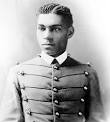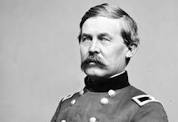|
By Adam De Gree
Henry Ossian Flipper Henry Ossian Flipper was born a slave in 1856, but he would achieve much by the time of his death in 1940. His life serves as an example of the courage and the challenges African Americans faced during Reconstruction. As the first black man to graduate from West Point and command African-American ‘Buffalo Soldiers,’ Flipper served with distinction. Yet white officers framed him for embezzlement only a few years into his military commission. Not until 1999 was his reputation restored by the United States government. Flipper was born the eldest of five to Isabelle and Festus Flipper in Georgia. His father worked as a shoemaker and carriage-trimmer for a wealthy slave dealer. After the Civil War, the family did as much as they could to better their own lives. As a young man, Flipper attended Atlanta University. There, he earned an appointment to West Point, the United States Military Academy. At West Point, Flipper and his fellow black cadets faced many challenges. White students at the academy regularly mistreated them. For example, Flipper wrote extensively about the many ways that white cadets would bully black students in order to gain the attention and favor of their superiors. Within several years he was the only black cadet who had not left the school. Flipper persevered in part because of his strong commitment to good behavior. After graduating from West Point in 1877, Flipper was given a commission as a second lieutenant. His command was a company of African-American troops in the Western outpost of Fort Sill, Oklahoma. These black frontier troops were called ‘Buffalo Soldiers’ by Native Americans. The Indians thought the hair of the black soldiers resembled buffalo fur. Flipper was the first black officer to command Buffalo Soldiers. According to army records, Flipper served with distinction at Fort Still. In addition to fighting in the Apache Wars and the Victorio Campaign, he contributed to many engineering projects. For example, he developed a system to drain stagnant pools of water that provided breeding grounds for malaria epidemics. In addition, he developed a reputation for honesty and trustworthiness with the local residents. He also started a close friendship with a white woman named Mollie Dwyer. Suddenly, in 1881, Flipper was accused of embezzling over $3,000 worth of commissary funds by Colonel Shafter, his commanding officer. He was arrested and put before a court martial. During the trial, it became clear that there was little evidence to support the allegations. Colonel Shafter repeatedly contradicted his own testimony and many witnesses testified to Flipper’s honesty. Since there was little chance of convicting Flipper of embezzlement, the court introduced a new charge – conduct unbecoming an officer and gentleman. Many argue that this charge had more to do with Flipper’s friendship with a white woman than any error he made in keeping track of military funds. He was found guilty and dishonorably discharged. Lieutenant Flipper was crushed by the dismissal. However, he resolved “to go forth into the world and by my subsequent conduct as an honorable man and by my character disprove the charges.” Over the next decades, Flipper worked throughout Mexico and the American Southwest as a civil and mining engineer, translator, surveyor, and cartographer. He became a well-respected Senate foreign relations expert on Mexican relations. Later, Flipper oversaw the planning and construction of the Alaskan railway system. His many achievements left an indelible mark on the West. Despite his continual efforts, Flipper could never get his name cleared by the Army. He tried to enlist again during the Spanish-American War and the first World War, but was denied both times. After attaining old age, he retired to Atlanta and lived with his brother until his death in 1940. Flipper’s death did not signal the end of the battle to reclaim his legacy. Several friends and family members continued to challenge the official narrative, and in 1976, the Army granted him a full pardon. However, his military rank and record would wait until a 1999 pardoning by President Bill Clinton. Today, the U.S. Army gives the Henry O. Flipper Memorial award to the most outstanding cadet at West Point in the areas of leadership, self-discipline, and perseverance. Numerous landmarks and memorials dot the country in his memory. Henry Ossian Flipper paved the way for thousands of black West Point graduates and officers who have served their country nobly. In his conduct in the Army and in the world, he set a fine example for all Americans. Interesting Questions for You to Discuss with Your Children and Students:
0 Comments
by Adam De Gree
John Buford Jr. was born on March 4, 1826. Just 37 years later, he would lose his life in the Civil War after receiving a deathbed promotion to the position of major general of Volunteers from Abraham Lincoln. Known for his key role in major battles including Gettysburg, Buford had a profound impact on Union victory and is remembered as an American hero. Buford was born in Kentucky, which became a battleground state in the Civil War. When he was eight years old, his family moved to Illinois. His father was a well-known Democrat who opposed Abraham Lincoln. Like many Americans, Buford’s ancestors had fought in the Revolution; his grandfather served under Robert E. Lee’s father. Growing up in a political family, Buford was very patriotic. After one year at Knox College in Illinois, he was accepted to the United States Military Academy at West Point. Divisions between American society increased as Buford grew older. The issue of slavery split the country into two factions – North and South. But while the split sounds simple, it wasn’t – many families were split into two opposing camps. For example, Buford’s father owned slaves, although he did not want to leave the Union. On the other hand, Buford’s wife Pattie was from a Southern family, and his in-laws fought for the Confederacy. At West Point, young men from the north and south trained to become officers, only to fight against each other when war broke out. In 1861, the Civil War erupted. While Buford could have chosen to fight with the rebellious Confederates, he stayed in the United States Army and quickly rose to the rank of brigadier general. Buford was a cavalry officer, and one of the finest in the war. He served with distinction in major battles such as the Second Battle of Bull Run and the Battle of Brandy Station. However, John Buford is best remembered for his role in the Battle of Gettysburg. The Battle of Gettysburg was one of the most important battles of the entire Civil War, and Buford secured the field for a Union victory. As tens of thousands of troops from North and South neared one another, Buford’s cavalry arrived in the town of Gettysburg, located on high ground. As he looked down, the general saw thousands of Confederate troops marching up the road and knew that he had to hold the high ground if the Union was to win the battle. He boldly ordered his much smaller force to defend their position against the advancing Rebels. They held out just long enough for reinforcements to arrive and staked out a strong defensive position that held for three bloody days of fighting. Buford served ably for some months after Gettysburg. However, it became clear that he was sick, possibly with typhus. This was a serious issue because during the Civil War, more American soldiers died of an illness than of a bullet wound. Buford was quartered at the home of a fellow general in Washington for his last days. President Lincoln, upon hearing that the hero of Gettysburg was on his deathbed, promoted him to “Major General for distinguished and meritorious service.” Buford, upon hearing of his promotion, asked, “Does he mean it?” and then said, “it is too late, now I wish I could live.” John Buford’s funeral was attended by the President, and his pallbearers were Union generals. He was buried at West Point, where he joined other American war heroes. In response to his death, the Philadelphia Enquirer ran the poem: No more to follow his daring form Or see him dash through the battle's storm No more with him to ride down the foe And behold his falchion's crushing blow Nor hear his voice, like a rushing blast As rider and steed went charging past ... Buford is dead! Interesting Questions to Discuss with your Children:
Copyright ©2017 by the Classical Historian. All Rights Reserved. by Jessica De Gree
Just one day after President Donald Trump’s inauguration, men and women worldwide participated in what they called a Women’s March. Marchers protested to raise awareness for a lack of respect of women’s rights. These so called “rights” include the “right” to get an abortion and access to free healthcare, along with respectful treatment of women from men. Protesters wanted to show the world that we should not tolerate hurtful and degrading words to women, such as statements Donald Trump has made. And, protesters also tried to show support for Planned Parenthood, an organization which openly supports and encourages abortions, in stating that they wanted the government to continue to allocate tax monies to the organization. These marchers equated the ability or choice to abort their pregnancies with women’s rights, a clearly false association. By so doing, many women who regretted their abortions, or who work to help those who seek an abortion find alternatives, were immediately unwelcome. In excluding these women, the Women’s March was much less of a protest for women, and more of a protest for progressivism. Organizers of the Women's March refused to let the voices of all women be heard, contrary to their publicized message, and instead bullied conservative women with their intense exclusivity. Pro-life groups such as Students for Life of America and New Wave Feminists, after asking to be partners or sponsors of the event, were declined for their pro-life standing. According to the board on the platform, the march’s message of inclusivity and solidarity did not extend to all women. By refusing to include all women in the Women’s March, and only including those who support abortion and believe abortion and other controversial subjects should be funded by tax dollars, the march demonstrates that it really isn’t a march for women, but rather a march for abortion. Whereas many people claim that the march intends to raise awareness for bullying, exclusivity, and poor treatment of women, it clearly only showcases the progressive feminists' views. In the Woman’s March platform found on their website, the protesters state their intentions of encouraging healthy environments for women in their family. They argue that women should not accept violence towards their bodies in any way. While this is a worthy issue to try to highlight, the rest of the platform underscores this message. The platform calls for the continuation of federal funding to Planned Parenthood, the organization which is responsible for more than 30% of the nation’s abortions, giving 1 in every 8 patients who visit Planned Parenthood an abortion. Clearly, this organization encourages abortions, a violent and harmful choice, instead of less violent and harmful options, such as adoption. So, although the platform initially seems to have a nice message that demands safety and security for women, the specific policies within the platform suggest otherwise. It seems strange that this event happened right after Trump’s inauguration. If it was truly a Women’s March, if it was a march that highlighted common problems women face and have been facing for a while, why had it not happened sooner? Why had it not happened after Bill Clinton’s scandals and Hillary Clinton's cover-ups? Or after Chris Brown attacked his girlfriend? The march was much more than a march for basic human rights. It was a political scheme directly attacking both Donald Trump’s presidency and Conservative values (both different things). Whenever there is a natural disaster and politicians use that to help build their appearance, people seem to always be dismayed. They point out that it is wrong to use the victim’s experience to better the politician’s own standings. In the Women's March, the organizers used the abuse of women to push a radical progressive agenda. They turned the emotions women have been holding inside into a political ploy. This abuse of women and of their emotions from real problems contradicts the very end the march was supposed to stand for. It is sad that this march has misled so many people from the ability to actually express their feelings of real hurt and pain. Questions: 1. What do the Women's March organizers claim were the goals of the Women's March? 2. When did the Women's March occur? 3. According to Ms. De Gree, what were the real goals of the Women's March? 4. What is your opinion of Ms. De Gree's analysis of the Women's March? 5. Optional Questions: Where did the Women's March occur? Which individuals or orgaanizations provided funding for coordinating and organizing the Women's March? http://liveactionnews.org/womens-march-removes-pro-life-group-list-partners/ https://www.womensmarch.com/principles/ |
John De GreeJohn De Gree writes the current events with a look at the history of each topic. Articles are written for the young person, aged 10-18, and Mr. De Gree carefully writes so that all readers can understand the event. The perspective the current events are written in is Judeo-Christian. Receive Articles and Coupons in Your EmailSign Up Now
For Email Marketing you can trust. Archives
June 2024
Categories
All
|
|
SUPPORT
|
RESOURCES
|
|




 RSS Feed
RSS Feed



